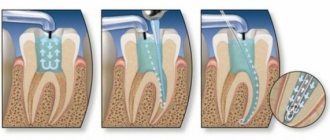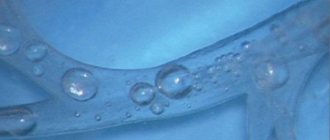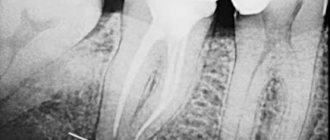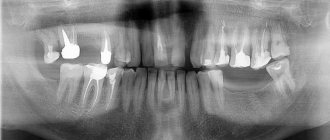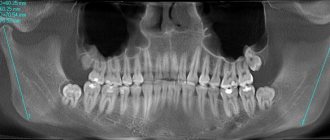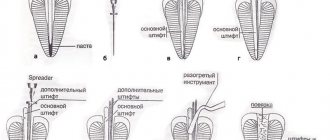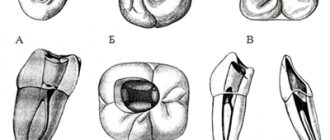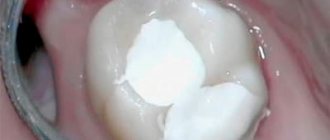The specific structure of the root canal determines the presence of a large number of branches, also known as microchannels. In situations where, as a result of filling, at least one of these cavities remains unclosed, there is a possibility of developing an inflammatory process, which, if prolonged, leads to tooth loss. The Thermafil system, which uses a soft gutta-percha composition, allows you to avoid such situations and achieve high-quality fillings.
General overview
The technology under consideration is one of the new methods of dental treatment, and guarantees the reliability of filling by placing heated gutta-percha in the cavity of the open canal, the basis for which is a plastic obturator. Three-dimensional obturation and complete sealing of the apex eliminate the likelihood of negative side processes that occur during the rehabilitation period. In addition, filling technology reduces the duration of the procedure and is recommended for use even with severe curvature of the canals.
Developed by Professor Johnson, the technology initially involved the use of medical steel rods coated with a layer of plastic material as a carrier. In modern Thermofil models, rigid polymer obturators of various diameters and tapers are used, on which marks are applied to facilitate control of the immersion of the equipment.
Heated gutta-percha has improved adhesive properties, ensuring tight fixation both at the base and in the cavity of the tubules. The presence of a plastic rod prevents shrinkage of the material. The method of using the system includes:
- Treatment of the obturator with a filling mass;
- Gradual introduction of the pin into the canal cavity;
- Natural filling of branches and volume as a result of the created pressure.
The technology of volumetric filling reduces the likelihood of infection of dental tissue, and allows you to reduce the amount of composite materials, which represent a potential source of negative impact on the jaw region. Practice shows that the painful sensations characteristic of the recovery period after medical intervention are expressed to a lesser extent.
It is worth noting that the protocol under consideration is associated with the clinic’s expenses for the purchase of special equipment, including a drill equipped with an endodontic attachment, an oven for softening gutta-percha, as well as sets of disposable instruments. As a result, the cost of treatment with the Thermafil system is higher than with alternative methods.
GuttaCore™ System: another step in the evolution of endodontics
The use of carrier obturators (Thermafil, GT Obturator, ProTaper® Obturator) is one of the most popular root canal filling techniques throughout the world, enjoying well-deserved recognition from leading experts in the field of endodontics, including L. Stephen Buchanan, Guiseppe Cantatore, Julian Webber, Pierre Machtou, James L. Gutmann and others.
This simple and effective technique can significantly reduce the doctor's working time, while ensuring high quality obturation, especially in narrow root canals and canals with complex anatomy (Buchanan, 2009; Christensen G., 1991; Dummer PMH, Lyle L, Rawl, Kennedy JK ., 1994; Cantatore G., 2001) (Fig. 1, 2).
Rice. 1. Root canals with pronounced curvature, filled with gutta-percha on a carrier. Rice. 2. Root canals with pronounced curvature, filled with gutta-percha on a carrier.
However, many dentists are still prejudiced against the use of obturators, preferring lateral or vertical condensation of gutta-percha. The main reason for this is the existence of common myths about gutta-percha on the carrier, often contradicting each other.
Myth No. 1
The use of obturators causes periodontal burns, as evidenced by postoperative sensitivity. Consequently, endodontic treatment will certainly fail. In fact, the correct use of gutta-percha on a carrier cannot lead to burns of periodontal tissues. The post-filling pain that occurs in some cases is due to the fact that the obturator, during its insertion into the root canal, promotes the air in the canal into the peri-root tissue. This sensitivity goes away on its own without the subsequent development of any complications.
Myth No. 2
When using obturators, there is a high risk of gutta-percha being removed beyond the root apex. Despite its simplicity, the filling technique using gutta-percha on a carrier is very demanding in terms of compliance with the rules for the formation of root canals. An important step is the calibration of the apical foramen, since the use of an obturator whose size is smaller than the diameter of the apical foramen can actually lead to the removal of gutta-percha into the periapical tissues. At the same time, with proper treatment of the root canal and strict adherence to the instructions for obturation of the canals using this technique, such a possibility is practically excluded.
Myth No. 3
Only the obturator carrier reaches the apex. Gutta-percha and sealer remain in the mouth and middle third of the canal. This option is indeed possible if the technique of preparation, irrigation and filling of the canal with gutta-percha on a carrier is not followed. There are several key factors to prevent this problem from developing:
- The root canal orifice must be sufficiently widened (“funnel-shaped”) to allow the obturator to enter freely without losing gutta-percha as it enters the canal.
- The root canal must be fully disinfected. A prerequisite for high-quality irrigation is the use of sodium hypochlorite solution and preparations to remove the smear layer formed during the formation of the canal, such as a 15-17% aqueous solution of EDTA or citric acid. This approach makes it possible to achieve not only high-quality obturation of the main canal, but also filling of its branches (lateral and deltoid canals, anastomoses between canals) with gutta-percha.
- The mouth and middle parts of the canal must be filled with sealer, ensuring smooth sliding of the obturator along its walls. In this case, the root sealant should not have a too dense consistency. The ideal option are sealers based on epoxy resin: AH Plus® (DentsplyTM), Adseal (Meta Biomed), etc.
- The obturator should be inserted into the root canal slowly and smoothly. Thermafil® obturators, with a 4% taper, are inserted into the canal within 3-4 seconds. Higher taper obturators (GT®, ProTaper® and WaveOneTM) - 6-8 seconds.
The use of carrier gutta-percha allows predictable successful results of root canal obturation, which is confirmed by numerous studies (Beatty et al., 1989; Dummer et al., 1993; Gen?oglu et al., 1993; Gen?oglu et al., 2002; Xu et al., 2007; Inan et al., 2007; Gen?oglu et al., 2007; Saunders et al., 1994; Gutmann et al., 1993; Dalat et al., 1994; Pathomvanich et al., 1996 ; Abarca et al., 2001; Kontakiotis et al., 2007).
Myth No. 4
Obturators are difficult to remove from the canal during repeated endodontic treatment.
Many clinicians encounter certain problems when it is necessary to unfill a canal filled with gutta-percha on a carrier. These problems are most often caused by the doctor’s lack of appropriate tools. Literature data indicate that unsealing a canal sealed with an obturator requires even less time than unsealing a canal filled with gutta-percha (Frajlich, 1998; Royzenblat, Goodell, 2007). The optimal solution for these purposes is to use machine-made nickel-titanium tools (ProFile®, GT®, etc.). In my practice, I use ProTaper® Retreatment files (Series D) (Figure 3).
Rice. 3. ProTaper® D Series Instruments.
These instruments allow you to literally remove the plastic carrier of the obturator within one minute, after which removing gutta-percha residues from the canal walls becomes a fairly simple task.
Myth No. 5
The plastic carrier of the obturator prevents the full preparation of the canal when placing pin structures.
When preparing a canal for a pin structure, before using reamers of the appropriate size, it is necessary to remove the obturator carrier to the required depth. For these purposes, diamond burs are often used (which is quite unsafe), ultrasonic tips and electric heating pluggers (System B, Calamus® Dual, BeeFill, etc.). However, in my opinion, the most predictable option is the use of special Post space burs (Dentsply™ Maillefer) (Fig. 4).
Rice. 4. Post Space® boron.
This turbine handpiece bur is used without water cooling and allows one movement to remove the plastic carrier from the root canal to the length of the pin structure.
GuttaCore™ system: characteristics and application methods
Based on the above prejudices, the main complaint of doctors against obturators is, one way or another, the presence of a plastic carrier in them.
In the near future, a product will be presented on the Russian market that demonstrates a fundamentally new concept of using gutta-percha on a carrier: GuttaCore™ obturators (Fig. 5), the carriers of which are made not of plastic, but of gutta-percha elastomer with cross-linked intermolecular bonds (cross-linked gutta-percha). Thus, the obturator consists entirely of gutta-percha in different forms (Fig. 6).
Rice. 5. GuttaCore™ obturators. Rice. 6. Structure of the GuttaCore™ obturator.
This ensures not only fast and high-quality three-dimensional obturation of root canals, but also ease of preparation of the canal for placing a pin and removing the root filling in case of need for repeated endodontic treatment. The carrier is removed from the root canals as easily as gutta-percha, since it is gutta-percha. Therefore, for these purposes we can use the same instruments as in canals filled using the lateral or vertical gutta-percha condensation technique.
Working with the GuttaCore™ system is very simple, but there are a number of key points to avoid mistakes when using it. Below is a step-by-step sequence for using GuttaCore™ obturators.
Stage No. 1
The root canal must be properly formed and disinfected.
The GuttaCore™ system is universal, that is, it can be used regardless of what instruments were used to treat the root canal. However, according to research, after preparation, root canals should have either a taper of at least 6% (.06) or a large apical foramen diameter. This is necessary to ensure their high-quality irrigation and three-dimensional obturation (Boutsioukis C, Gogos C, Verhaagen B et al., 2010). When using the GuttaCore™ System, the root canal must be expanded to at least a 20.06 or 25.04 size.
Stage No. 2
The appropriate GuttaCore™ obturator size is selected. If instruments with a taper of .06 or greater were used for root canal preparation, an obturator that is the same size as the finishing nickel-titanium file is selected. If tools with a taper of .04 were used, one size smaller (Table No. 1).
Table No. 1. Selecting the appropriate GuttaCore™ obturator size.
Apical taper .04 | GuttaCoreTM obturators | Apical taper .06 | GuttaCoreTM obturators | WaweOneTM Tools | ProTaper® Tools |
| 20/.04 | — | 20/.06 | 20 | Small | F1 |
| 25/.04 | 20 | 25/.06 | 25 | Primary | F2 |
| 30/.04 | 25 | 30/.06 | 30 | — | F3 |
| 35/.04 | 30 | 35/.06 | 35 | — | — |
| 40/.04 | 35 | 40/.06 | 40 | Large | F4 |
| 45/.04 | 40 | 45/.06 | 45 | — | — |
| 50/.04 | 45 | 50/.06 | 50 | — | F5 |
| 55/.04 | 50 | 55/.06 | 55 | — | — |
| 60/.04 | 55 | 60/.06 | 60 | — | — |
| 70+/.04 | 60 | 70+/.06 | 70 | — | — |
| 80+/.04 | 70 | 80+/.06 | 80 | — | — |
| 90+/.04 | 80 | 90+/.06 | 90 | — | — |
Under no circumstances should gutta-percha be cut from the tip of the obturator, as this may damage the wearer.
Stage No. 3
A very important step in ensuring predictable and high-quality three-dimensional obturation is root canal calibration. For this purpose, each GuttaCore™ blister, in addition to five obturators, contains a verifier of the appropriate size and taper. This is a hand-held instrument that is passively inserted into the working length of the root canal. If the verifier is not passively fitted to its full length, it can be used as a finishing file to further widen the apical portion of the canal.
Stage No. 4
When using GuttaCore™ obturators, the sealer is applied in a thin layer only to the mouth or, in the case of long root canals, the mouth and middle part of the canal. To apply the sealer, you can use a paper pin, a sharp probe, or in the case of using AH Plus® Jet sealer, a special mixing nozzle (Fig. 7).
Rice. 7. AH Plus® Jet sealer with mixing nozzle for applying material directly into the root canals.
When inserted into the root canal, the heated obturator will evenly distribute the root sealant along its walls. If there is an excessive amount of sealer or if it is applied to the full working length, there is a very high risk of its extrusion into the periapical tissues.
Stage No. 5
The obturator is adjusted to the working length and then placed in the holder of one of the heating elements of the Thermaprep 2® oven (Fig. 8).
Rice. 8. Thermaprep 2® oven.
Distinctive characteristics of the Thermaprep 2® oven are the rapid three-dimensional heating of the obturators while maintaining the properties of the gutta-percha carrier, as well as the possibility of simultaneous operation of both heating elements.
When working with the GuttaCore™ system, in contrast to obturators with a plastic carrier, the minimum heating level is set on the working panel of the furnace, regardless of the size of the obturator: 20-25.
By gently pressing the holder, the obturator is placed into the Thermaprep 2® heating element. At the same time, the oven’s operating cycle automatically starts and the indicator light lights up. The possibility of simultaneous operation of both heating elements allows, if necessary, to heat two obturators at once. When heating is complete, the oven will beep and the indicator light will start flashing. By gently pressing, the holder is raised, the obturator is removed and slowly, without rotation, is inserted into the root canal to the working length.
If access to the root canals is difficult, especially in the lateral teeth when opening the mouth is difficult, you can fix the GuttaCore™ obturator carrier with tweezers (Fig. 9), remove the handle by shaking it from side to side, and, holding the obturator with tweezers, insert it into the channel (Fig. 10).
Rice. 9. Use of GuttaCore™ obturators for difficult access to root canals. Rice. 10. Use of GuttaCore™ obturators for difficult access to root canals.
Stage No. 6
After inserting the obturator into the root canal, the plasticized gutta-percha can be condensed at the orifice of the root canal using a plugger. This creates additional hydrodynamic pressure, allowing gutta-percha to even better fill the branches of the main canal, such as the lateral and deltoid canals, anastomoses between canals, etc. During the condensation process, it is necessary to firmly hold the obturator by the handle to avoid its displacement.
Stage No. 7
The final stage of obturation is the removal of the handle and carrier above the level of the orifice. When using the GuttaCore™ system, there is no need to use special Thermacut burs for this purpose. You can either cut the carrier off at the mouth level using a regular ball bur or a sharp excavator, or simply break it off with light lateral movements.
To clean the tooth cavity from residues of gutta-percha and sealer, you can use a cotton ball soaked in chloroform or ethyl alcohol.
Conclusion
The evolution of endodontics is moving along the path of simplifying the technical part of the procedures and reducing the doctor’s working time required to perform them. New instruments, materials, equipment and accessories are being developed to reduce the number of working steps and make endodontic treatment less labor-intensive. At the same time, of course, much attention is paid to simultaneously increasing the predictability of results and the success of treatment in general. The development of the GuttaCore™ obturators represents a truly revolutionary step in the evolution of endodontics. The use of this system allows you to quickly and effortlessly achieve high-quality three-dimensional obturation in situations where the doctor may encounter certain problems when performing other root canal filling techniques (Fig. 11-13).
Rice. 11. Examples of the use of GuttaCore™ obturators in clinical situations with non-standard root canal anatomy. Rice. 12. Examples of the use of GuttaCore™ obturators in clinical situations with non-standard root canal anatomy. Rice. 13. Examples of the use of GuttaCore™ obturators in clinical situations with non-standard root canal anatomy.
Literature
- Buchanan S. Common misconceptions about supported occlusion materials / Endodontic Practice, December 2009; 7-11.
- Christensen G. Improved Thermafil concept well accepted. CRA Newsletter 1991; 12:4.
- Cantatore G. Thermafil versus System B. Endod Pract 2001; 5:30-39.
- Dummer PMH, Lyle L, Rawl, Kennedy JK. A laboratory study of teeth obturated by lateral condensation of gutta-percha or Thermafil obturators. Int Endod J 1994; 27:32-38.
A complete list of references is in the editorial office.
Stages of filling
The algorithm for restoring the integral structure of the crown includes the following steps:
- Removal of pulp and expansion of the canal opening;
- Formation of a cone-shaped cavity and extraction of infected dentin;
- Determination of the working depth of the channel;
- Antiseptic treatment of all internal areas;
- Rinsing the cavity with a chlorhexidine solution;
- Drying and introducing sealer;
- Installation of a polymer rod and filling the lumen;
- Removing excess material;
- Polymerization of gutta-percha at the mouth of the canal;
- X-ray examination and repeated disinfection.
Implementation of the protocol requires special attention to a number of factors that can affect the quality of filling.
Correct determination of working depth
Because the technique involves filling the canal and all branches, it is important to ensure that the material used is sufficient to reach the bottom of the cavity. Otherwise, there is a high probability of developing complications, including inflammatory processes, pain, cyst formation or periodontitis.
Compliance with channel processing techniques
Mechanical expansion of the hole, elimination of existing defective areas and irregularities - all these are factors affecting the quality of filling the cavity with gutta-percha material. This is especially important when working with narrow and curved canals that require careful processing.
Advantages of filling using THERMAFIL method
The root canals of a tooth have a complex anatomical structure. In addition to the main channel, there are also a lot of different side branches, which are called microchannels. Many microchannels are located in the upper part of the main canal, and this is the most difficult and important area for filling. If you do not fill at least the smallest part of the canals, this can lead to inflammation and, as a result, loss of the entire tooth.
Simple filling methods are not as effective as Thermafil. As practice has shown, if the patient agreed to a cheaper method, then unfilled canals could be observed on x-rays, and this only leads to complications. THERMAFIL system is completely free of such pitfalls. Softened and heated gutta-percha under good pressure is introduced into the root canal of the tooth and completely fills the main canal, as well as all micro-channels. After such an operation, the canal is sealed to the very top. Gutta-percha is introduced into the tooth using a plastic carrier or rod, which, due to its properties, fills even the most curved canals. If suddenly there is a threat of re-treatment, for example, there is an urgent need to prepare the root canal for a pin structure, then THERMAFIL material can easily be removed from the root canal.
During the entire period of use of THERMAFIL, many observations were made. It has been proven in practice that the root canal is hermetically sealed without voids. THERMAFIL seals root canals 20 times stronger than a standard gutta-percha point. THERMAFIL is 4 times more effective than the same filling, but using a syringe.
A filling pin or obturator is a rod coated with a thin layer of gutta-percha and shaped like a cone. THERMAFIL system takes place in several stages. At the very beginning of the operation, the patient's dental nerve or pulp (neurovascular bundle) is removed. After this, the root canal is expanded, giving it a conical shape. At this stage, infected dentin is eliminated from the walls of the root canal. Using an apescolator (a device that determines the length of the root canal), the exact length is determined for further processing and filling of the tooth. Next, the canal is processed and dried, after which filling begins. After the hermetic filling, the dentist schedules the next appointment, at which the tooth will be completely restored.
Advantages and disadvantages
Positive aspects noted when using the Thermophile system include:
- Guaranteed sealing of the canal cavity;
- Minimal risk of inflammation after filling;
- Low level of toxicity of materials;
- Preservation of an integral apical structure;
- Control over the depth of penetration of the rod;
- Free access for re-treatment;
- No pain during the rehabilitation period.
The only technical drawback characteristic of all composite materials is the likelihood of minimal shrinkage of the formed filling.
What it is?
The Thermafil system is a new method of dental treatment used for effective filling of tooth canals.
To do this, heated gutta-percha is used on a plastic carrier - an obturator. Today, this is the most effective canal filling system with three-dimensional obturation and complete sealing of the apex. This treatment method significantly reduces the specialist’s work time and guarantees high-quality filling. Even the narrowest, curved canals can be reliably filled with filling material.
General principles of the technique
This filling method was developed by Professor B. Johnson. Initially, metal rods coated with a primary gutta-percha layer were used as a carrier. Over time, the system has been improved and is now widely used in dentistry.
The thermophile consists of a hard plastic obturator that is coated with a layer of gutta-percha. For ease of use, the rods come in different thicknesses and tapers. Each of them has marks that allow you to control the depth of insertion.
When heated, gutta-percha acquires good adhesiveness, due to which it adheres perfectly to the rod, and then directly to the canal. Due to the fact that Thermafil contains a plastic carrier, shrinkage of the material is prevented.
The usage procedure is as follows:
- the plastic rod is treated with heated gutta-percha;
- the pin is inserted directly into the canal with slow movements;
- being under pressure, gutta-percha densely fills all existing branches and the rest of the channel itself.
This method of carrying out the procedure, due to the tight sealing of the entire root system, received its second name - volumetric filling.
After such treatment, the risk of possible development of pathogens inside the tooth is significantly reduced.
The use of the Thermofil system allows the use of fewer toxic composite materials. Thus, the severity of pain after tooth treatment is reduced.
The technique requires considerable financial costs to purchase the following tools:
- drill with a special endodontic attachment;
- ovens for heating gutta-percha;
- endodontic instruments, most of which are expensive and can only be used a few times.
All of the above explains why such a convenient and simple treatment procedure is not offered in all clinics, mainly in private institutions.
What is the advantage of thermophile?
This procedure was invented several years ago through the joint development of scientists to find optimal methods for completely and effectively filling deep dental canals. Traditionally, the best substance used for this operation is gutta-percha, a natural material that is extracted from the sap of tropical plants. Possessing such qualities as plasticity, flexibility and radiopacity, gutta-percha has been used for over two centuries to effectively fill the internal canals of teeth.
However, for many years, dentists have been faced with the main problem in this regard - the impossibility of fully filling the canals due to their particular complexity, difficulty in determining the length, and analyzing the lateral canaliculi. Only the thermophilic filling system, which is based on the ability to soften gutta-percha to the required level using a special device and qualitatively fill the entire canal with it, has made it possible to make a significant step forward in this regard.
When is the method most effective?
The use of the system is most effective in the following cases:
- for infectious lesions of the dental root system;
- when removal of the inflamed pulp is required;
- in case of severe curvature of channel branches and the channel itself;
- with the initial destruction of the root canal;
- to shape the cavity before filling;
- direct installation of the filling.
The most difficult case is the need to treat a previously filled tooth, if the filling of the holes was carried out poorly. In this case, three-dimensional filling is also at its best.
Many clinical studies have been conducted that have proven the effectiveness of the Thermofil system. With its help, it is possible to reliably seal the canal cavity while maintaining the result for many years to come.
Benefits of filling teeth with gutta-percha:
- High speed operation about 30-40 minutes
- High-quality root canal sealing
- Possibility to fill the entire volume of the root canal with paste
- Reliable antiseptic treatment
- Eliminating the risk of inflammatory processes
- Careful doctor supervision at all stages of canal filling
In conclusion, it should be said that today filling with gutta-percha is considered the most reliable and safe, in which you can fill a tooth with high quality and not be afraid of the development and treatment of caries, the penetration of infections, or the risk of losing a tooth. Leading European and Russian dental clinics successfully perform all types of gutta-percha fillings.

